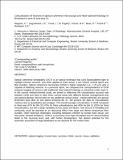Colocalization of neurons in optical coherence microscopy and Nissl-stained histology in Brodmann’s area 32 and area 21
Author(s)
Magnain, Caroline; Augustinack, Jean C.; Tirrell, Lee; Fogarty, Morgan; Frosch, Matthew P.; Boas, David A; Fischl, Bruce; Rockland, Kathleen S.; ... Show more Show less
Download429_2018_1777_ReferencePDF.pdf (1.038Mb)
Publisher Policy
Publisher Policy
Article is made available in accordance with the publisher's policy and may be subject to US copyright law. Please refer to the publisher's site for terms of use.
Terms of use
Metadata
Show full item recordAbstract
Optical coherence tomography is an optical technique that uses backscattered light to highlight intrinsic structure, and when applied to brain tissue, it can resolve cortical layers and fiber bundles. Optical coherence microscopy (OCM) is higher resolution (i.e., 1.25 µm) and is capable of detecting neurons. In a previous report, we compared the correspondence of OCM acquired imaging of neurons with traditional Nissl stained histology in entorhinal cortex layer II. In the current method-oriented study, we aimed to determine the colocalization success rate between OCM and Nissl in other brain cortical areas with different laminar arrangements and cell packing density. We focused on two additional cortical areas: medial prefrontal, pre-genual Brodmann area (BA) 32 and lateral temporal BA 21. We present the data as colocalization matrices and as quantitative percentages. The overall average colocalization in OCM compared to Nissl was 67% for BA 32 (47% for Nissl colocalization) and 60% for BA 21 (52% for Nissl colocalization), but with a large variability across cases and layers. One source of variability and confounds could be ascribed to an obscuring effect from large and dense intracortical fiber bundles. Other technical challenges, including obstacles inherent to human brain tissue, are discussed. Despite limitations, OCM is a promising semi-high throughput tool for demonstrating detail at the neuronal level, and, with further development, has distinct potential for the automatic acquisition of large databases as are required for the human brain.
Date issued
2018-10Department
MIT-IBM Watson AI Lab; Massachusetts Institute of Technology. Institute for Medical Engineering & Science; Harvard University--MIT Division of Health Sciences and TechnologyJournal
Brain Structure and Function
Publisher
Springer Science and Business Media LLC
Citation
Magnain, C. et al. "Colocalization of neurons in optical coherence microscopy and Nissl-stained histology in Brodmann’s area 32 and area 21." Brain Structure and Function 224, 1 (October 2018): 351–362 © 2018 Springer-Verlag GmbH Germany, part of Springer Nature
Version: Author's final manuscript
ISSN
1863-2653
1863-2661